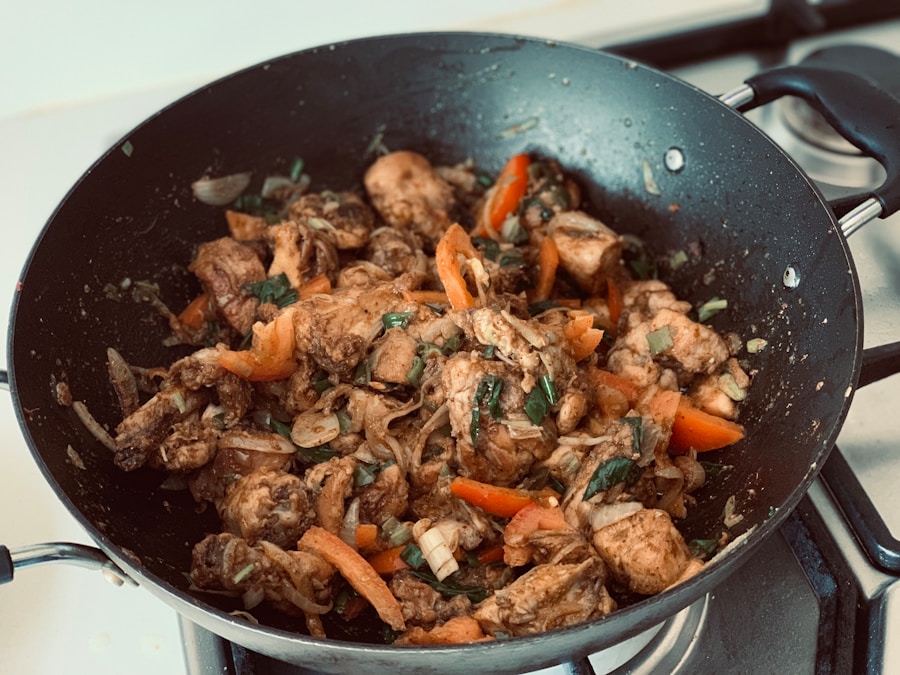Download links
How to install The Ultimate Guide to Making Adobo: A Flavorful Tradition APK?
1. Tap the downloaded The Ultimate Guide to Making Adobo: A Flavorful Tradition APK file.
2. Touch install.
3. Follow the steps on the screen.
Description
Adobo, a dish that has become synonymous with Filipino cuisine, boasts a rich and complex history that reflects the diverse cultural influences that have shaped the Philippines over centuries. The term “adobo” is derived from the Spanish word “adobar,” which means “to marinate.” This connection to Spanish colonial rule, which lasted for over three hundred years, is significant in understanding how adobo evolved into the beloved dish it is today. However, the roots of adobo can be traced back even further, to indigenous cooking practices that utilized vinegar and spices for preservation and flavor enhancement long before the arrival of the Spaniards.
The earliest forms of adobo were likely simple preparations of meat or fish marinated in vinegar, salt, and local spices. These methods were practical, as they allowed for the preservation of food in a tropical climate where spoilage was a constant concern. The introduction of soy sauce and other ingredients during the Spanish colonial period further enriched the dish, leading to the myriad variations we see today.
Over time, adobo became more than just a method of cooking; it evolved into a cultural symbol, representing the resilience and adaptability of Filipino culinary traditions amidst foreign influences.
Key Takeaways
- Adobo has a long history dating back to the Spanish colonization of the Philippines, and has evolved into a beloved national dish with various regional variations.
- The key ingredients of adobo include vinegar, soy sauce, garlic, and bay leaves, but there are many variations that incorporate different proteins and additional spices.
- Cooking techniques for adobo can vary, but the most common methods involve marinating the meat in the adobo sauce before simmering or braising it until tender.
- Regional differences in adobo include the use of coconut milk in the Bicol region, and the addition of pineapple in some Visayan versions, showcasing the diverse flavors across the Philippines.
- Adobo can be served with a variety of side dishes such as steamed rice, pickled vegetables, or fresh salads, and pairs well with beverages like iced tea or coconut water.
- Expert tips for perfecting adobo include using a combination of vinegar and soy sauce for a balanced flavor, and allowing the dish to marinate for at least an hour before cooking for maximum flavor infusion.
Ingredients and Variations: Understanding the Key Components of Adobo
At its core, adobo is characterized by a few essential ingredients that form the foundation of its flavor profile. The primary components typically include meat—commonly chicken or pork—vinegar, soy sauce, garlic, bay leaves, and black peppercorns. The vinegar serves not only as a marinade but also as a key flavoring agent that imparts a tangy depth to the dish.
While these ingredients are standard in many adobo recipes, regional variations abound, showcasing the creativity and resourcefulness of Filipino cooks. For instance, in some areas, coconut milk is added to create a creamier version known as “adobo sa gata.” In contrast, others may incorporate fruits like pineapple or mango for a sweet twist.
Additionally, seafood adobo is popular in coastal regions, where fish or shrimp are marinated and cooked in a similar style. Each variation tells a story of local ingredients and culinary traditions, making adobo a versatile dish that can be adapted to suit different palates.
Cooking Techniques: Mastering the Art of Making Adobo

The final step often involves reducing the sauce to achieve a thicker consistency, which can be adjusted according to personal preference. Mastering these techniques is essential for creating an authentic adobo that captures the essence of this beloved dish. For more information on the Maillard reaction, you can visit ScienceDirect.
Regional Differences: Discovering the Diverse Flavors of Adobo Across the Philippines
| Region | Main Ingredient | Distinct Flavor |
|---|---|---|
| Manila | Pork | Sweet and Tangy |
| Bicol | Coconut Milk | Spicy and Creamy |
| Visayas | Chicken | Garlicky and Salty |
| Mindanao | Seafood | Rich and Savory |
The Philippines is an archipelago composed of over 7,000 islands, each with its own unique culinary traditions and regional specialties.
In Luzon, particularly in regions like Pampanga, adobo is often prepared with a sweeter profile, incorporating sugar or even pineapple juice into the marinade.
This version is known as “adobong puti,” characterized by its lighter color due to the absence of soy sauce. In contrast, the Visayas region showcases its own take on adobo with “adobong bisaya,” which may include additional spices such as ginger or lemongrass for an aromatic twist. Meanwhile, Mindanao offers its own unique variations influenced by indigenous cultures and local ingredients.
For example, some Mindanaoan recipes incorporate coconut milk or even durian for an adventurous flavor profile. These regional differences highlight not only the diversity of Filipino cuisine but also the adaptability of adobo as it evolves to reflect local tastes and traditions.
Serving Suggestions: Pairing Adobo with Complementary Side Dishes and Beverages
Adobo is often served as a centerpiece dish during family gatherings and celebrations, making it essential to consider complementary side dishes and beverages that enhance the overall dining experience. A classic pairing is steamed white rice, which serves as a neutral base that absorbs the rich flavors of the adobo sauce. The simplicity of rice allows the bold taste of adobo to shine while providing a satisfying contrast in texture.
In addition to rice, various side dishes can elevate an adobo meal. For instance, sautéed vegetables such as bok choy or green beans add freshness and color to the plate. Some families may also serve pickled vegetables or “atsara” (pickled papaya) alongside adobo to introduce a tangy element that balances the dish’s richness.
When it comes to beverages, traditional options like “sago’t gulaman” (a sweet drink made from tapioca pearls and gelatin) or even local beers can complement adobo beautifully. These pairings not only enhance the meal but also create a well-rounded dining experience that celebrates Filipino culinary culture.
Tips and Tricks: Expert Advice for Perfecting Your Adobo Recipe

Creating the perfect adobo requires attention to detail and an understanding of how flavors develop during cooking. One essential tip is to allow ample marination time; ideally, marinating overnight will yield more flavorful results as the meat absorbs all the spices and seasonings. Additionally, using high-quality vinegar is crucial; different types of vinegar can impart varying levels of acidity and flavor complexity.
For instance, cane vinegar is commonly used in traditional recipes for its mild yet distinct taste. Another important aspect is adjusting cooking times based on the type of meat used. Chicken typically cooks faster than pork; thus, it’s advisable to monitor tenderness closely to avoid overcooking.
Some cooks also recommend adding hard-boiled eggs during the last stages of cooking for an added layer of flavor and texture. Finally, don’t hesitate to experiment with different ingredients or techniques; adobo is inherently flexible, allowing cooks to personalize their recipes while still honoring tradition. By following these tips and embracing creativity in the kitchen, anyone can master this iconic Filipino dish and make it their own.
FAQs
What is Adobo?
Adobo is a popular Filipino dish that involves marinating meat, seafood, or vegetables in a mixture of vinegar, soy sauce, garlic, and other seasonings, and then simmering it until tender.
What are the main ingredients in Adobo?
The main ingredients in Adobo typically include vinegar, soy sauce, garlic, bay leaves, and black peppercorns. The dish can be made with various proteins such as chicken, pork, beef, or seafood.
How is Adobo cooked?
Adobo is typically cooked by marinating the protein in the vinegar and soy sauce mixture for a period of time, and then simmering it in the same marinade until the meat is tender and the flavors have melded together.
What is the origin of Adobo?
Adobo is a traditional Filipino dish that has its roots in Spanish cuisine. The cooking method of marinating and stewing meat in vinegar and spices was introduced by the Spanish during their colonization of the Philippines.
What are the variations of Adobo?
There are many regional and personal variations of Adobo in the Philippines. Some variations include using coconut milk, adding potatoes or other vegetables, or using different types of protein such as fish or tofu.





